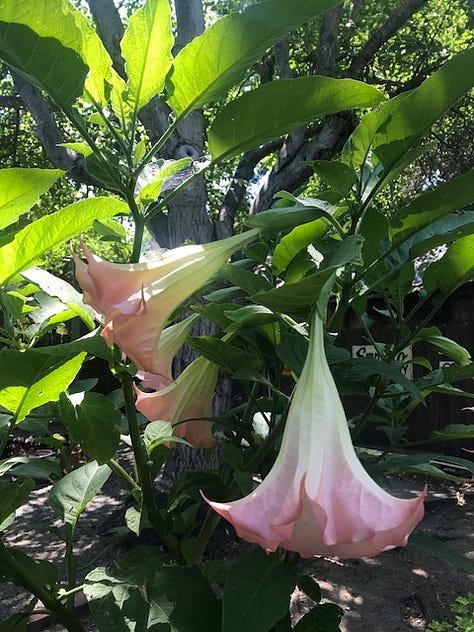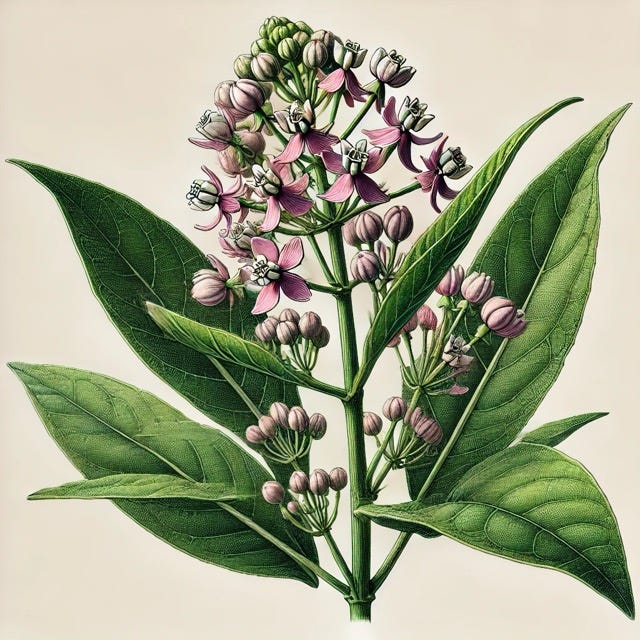Green Wednesday: Protecting Pets from Toxic Plants and Monarchs’ Fight for Survival
By Cindy Watter, UC Master Gardener of Napa County / Kathleen Scavone
Every Wednesday, Napa Valley Features includes posts from Napa Climate NOW!, a local nonprofit advocating for smart climate solutions, alongside the ongoing series by the U.C. Master Gardeners of Napa County, who share research-based horticultural advice. While we always feature garden stories each week, we occasionally include contributions from local naturalists like Kathleen Scavone and other science-oriented experts in the climate space. Together, these voices provide valuable insights into our local natural habitats, biological wonders and climate-related topics relevant to our region.
Today, Scavone shares her insights in "Monarchs and the Magic of Milkweed.” The piece explores the critical role of milkweed in sustaining monarch butterfly populations and highlights ongoing efforts to preserve their habitat amidst environmental challenges.
Additionally, Cindy Watter shares with us "Pay Close Attention to Poisonous Plants.” This article warns gardeners about common toxic plants that pose risks to pets and children and offers advice on safer gardening choices.
Pay Close Attention to Poisonous Plants
By Cindy Watter
NAPA VALLEY, Calif. — During the summer of 2023 I did a lot of traveling, and my garden didn’t get the oversight it needed. I say “oversight” because my yard has a mind of its own. Just before I took off, I looked around the place and noticed a flash of red stems near the back. “The amaranth has come back! Won’t the birds be happy!” I thought and then rushed to the airport.
When I returned a month later, what had appeared as amaranth to my nearsighted eyes revealed itself to be highly poisonous pokeweed, now 12 feet tall.
I have written in the past about poisonous plants in my yard — calla lilies, foxgloves and my favorite, brugmansia (which is hallucinogenic as well as highly toxic). While acknowledging that these plants are dangerous, I have always added the lighthearted comment that the plants taste so terrible that no rational person — or dog or cat — would ingest them.
Lately I have been rethinking that assertion. Dogs, cats and babies, plus adults wanting to experience a state of altered consciousness, are not overburdened with common sense. Oh, and there is another reason. I will be a grandmother any day now.
I called up Silverado Veterinary Hospital and asked the receptionist if anyone had ever brought in a pet that had been poisoned by a landscape plant. She answered that they did get the occasional cat that had eaten a lily.



Calla lilies — or any lily and most bulbs — can cause acute gastric distress and organ damage. What’s tempting about a lily? Cats might like the taste of the pollen or be attracted to the flower’s fragrance. The vets at Silverado can save a cat that has eaten a poisonous plant, but I began to rethink my cavalier attitude. (Note: Dogs don’t seem to be attracted to lilies, but cats really like them.)
Most plants that are toxic to pets are also toxic to humans, but symptoms are worse in dogs, cats and young children because of their smaller size. Most of these plants cause vomiting and diarrhea, resulting in dehydration, which is much more dangerous for small creatures.
There are many toxic plants, but these are the most common: aloe, anemones, chrysanthemums, crocus, cyclamen, daffodils, daisies, hyacinths, jade plants, lilies, lilies of the valley, rhododendrons and tulips. Sago plants are probably the most dangerous. Just one or two seeds can poison you.
Plants that are toxic but rarely ingested by pets are brugmansia, castor bean (source of ricin), daphne, foxglove, jimson weed, nicotiana, pokeweed and yew. You can see the fine line between a helpful pharmaceutical and a risky substance in this list. Yew is used in chemotherapy to cure cancer, and foxglove is a source of digitalis, a heart medicine.
That pokeweed in my back yard is going to have to come out. The birds love it, and I doubt that my dog or the visiting cats will eat it. However, the berries are shiny and black, borne on cherry-red stems with green leaves that make the plant eye-catching. I can imagine a child wanting to eat the berries, especially because they have a syrupy scent. Pokeweed berries are extremely toxic.
I also won’t replace the daphne that froze last winter, nor will I plant any more foxgloves. Some people fence off their risky plants, but I suspect my grandchild will be the sort of person who will think a fence is to be climbed over, so I will have a plant giveaway instead. I will be thrilled to rip out the anemone, which hasn’t done well here since the summers have become so hot.
Fertilizers can be dangerous, too. When I planted my tiger lilies, my new poodle puppy was anxious to help. She really liked to eat the bone meal that went into the planting hole with the bulbs. I stopped that behavior by covering the tiger lily bed with mulch and, on top of that, wire mesh. While bone meal isn’t poisonous, it will clump into a ball in the pet’s stomach. The resulting blockage is expensive to remedy.
The UC Davis Veterinary School has a Toxic Plant Garden that is well worth a visit. All the plants are clearly labeled. It is a surprise to see so many common landscaping shrubs, such as oleander, in this collection.
You may ask, “What can I plant without killing small animals and children?” You can plant fruits, vegetables, herbs, wildflowers, California natives and roses, just for a start. So no need to feel deprived. I have noticed lately a horticultural fad of growing a goth-style garden filled with plants in the poisonous nightshade family. It’s an amusing conceit, but a poisoned child or pet is no joke.
Workshop: Join UC Master Gardeners of Napa County for a workshop on “Soils, Compost and Mulch” on Wednesday, Oct. 9, from 6:30 to 8:30 p.m., at the Pelusi Building, 2296 Streblow Drive in Napa. Pat Costello, the city's water resources analyst, will summarize the eight principles of water-wise landscaping. Master Gardeners will examine local soil types and demonstrate how to improve your soil with aeration, amendments and mulch. Register here.
Workshop: Join UC Master Gardeners of Napa County for a “Water-Wise Plant Show” on Wednesday, Oct. 6, from 6:30 to 8:30 p.m., at the Pelusi Building, 2296 Streblow Drive in Napa. Local landscape designers will demonstrate that drought-tolerant is anything but boring. Register here.
Help Desk: The Master Gardener Help Desk is available to answer your garden questions on Mondays and Fridays from 10 a.m. until 1 p.m. at the University of California Cooperative Extension Office, 1710 Soscol Ave., Suite 4, Napa. Or send your questions to mastergardeners@countyofnapa.org. Include your name, address, phone number and a brief description. For best results attach a photo.
If today's garden-focused story captured your interest, explore these related articles:
Transform Your Garden — Embrace Low-Maintenance Native Plants
Weekender Encore: Nature’s Sweet Treasure — The Blackberries of Napa Valley
Cindy Watter is a UC Master Gardener of Napa County.
Monarchs and the Magic of Milkweed
By Kathleen Scavone
NAPA VALLEY, Calif. — Most of us have had the pleasure of enjoying the flutter of western monarch butterflies as they drift by like otherworldly angels. I'll never forget the magnificent monarch clusters of brown and orange that I spied on eucalyptus trees at the edge of Bodega Dunes Campground in Bodega Bay years ago, or the monarchs that gathered on trees at Pacific Grove. Today monarchs are, sadly, suffering a population decline due to a host of reasons such as habitat degradation, pesticide use and climate change, but there is hope for the tenacious pollinators' survival. Erin Arnsteen is the Western Program Coordinator of Monarch Joint Venture and is working to conserve monarch butterflies and their habitat.
Monarch Joint Venture is a 501(c)(3) nonprofit organization that partners with numerous agencies, organizations and academic programs with the common goal of protecting monarch migration across our country. Some of their partners include the Almond Board of California, Audubon International, Bayer, the Bureau of Land Management, the Environmental Defense Fund and many more. MJV was founded in 2008 to "uphold the United States' priorities in the North American Monarch Conservation Plan".
Why worry about monarchs and other pollinators? The U.S. Department of Agriculture says that three-fourths of the flowering plants on our planet, along with around 35% of the food crops across the world, rely upon pollinators such as butterflies, bats, bees and birds to pollinate flowers and crops. That makes efforts by Arnsteen and her team at MJV to enhance monarch habitat and encourage science education for school-age children, gardeners and farmers alike a top priority.
Arnsteen is laboring to school the public on monarchs and their habitat needs to ensure the butterfly's survival, since environmentally friendly gardens and farms, as well as the surrounding lands, have such a great influence on the monarch's ability to thrive. Milkweed is a vital feature of their habitat needs since it is the butterfly's host plant. Monarch butterflies only lay their eggs on milkweed plants and their larvae only eat milkweed's leaves.
Another great feature about milkweed and a reason to encourage its proliferation is its ability to entice pollinators to visit, which makes it an attractive hedge in agricultural settings. Milkweed may also increase crop production through its ability to welcome various species of pollinators. Additionally, home gardeners are learning that by including milkweed in their backyard's landscaping, they are receiving double the benefits as a pollinator as well as having a teaching aid to instruct children with great science lessons on the life cycle of the monarch butterfly.
MJV offers help for monarchs and their host plant, milkweed. On their website, you can learn how and where to purchase seeds for pollinator plants and milkweed. You can also find out where to locate free plants such as those periodically offered by the St. Helena Farmer's Market, advice on Farm Bill programs, how to connect to resources and practitioners in the Napa Valley and more.
One valuable MJV program offers technical assistance for farmers and landowners (found here).This program helps farmers and landowners locate plants, seeds and equipment rentals, and teaches them where to create pollinator habitat.
Some other examples of MJV's educational programs and resources include public classes, webinars, curriculum resources for students and teachers, professional development workshops, grant opportunities and more. Educational webinars for various age groups are offered on their website. One webinar, called Chrysalis Crew, is recommended for kids ages 8-12. This $20 course is available online, enabling students to engage in the videos and activities at their own pace, and teaches them about monarch life cycle, sensory systems, migration and more. When completed, they'll not only gain valuable science lessons, but a certificate of completion and other items to prompt them to continue their nature explorations and possibly become monarch ambassadors.
Working in concert with Arnsteen at MJV is the Western Monarch Society of Napa County, an assemblage of local gardeners, farmers and citizen science land stewards all holding equivalent ideas as local land stewards. They endeavor to create native pollinator habitat through plant giveaways on appropriate days and provide resources to aid in the prevention of pollinator collapse, with a focus on western monarch butterflies. Through their concentrated efforts on cultivating and then providing the public with native milkweed and other nectar plants on which pollinators rely, the Western Monarch Society of Napa County hopes to generate a network of like-minded branches across California.
Another link in the chain to aid monarchs and milkweed is the California Department of Fish and Wildlife. The CDFW explains the importance of pollinators like monarchs and the vital role butterflies, bats, bees, hummingbirds and other pollinators play as keystone species in our state. CDFW has worked for decades to conserve monarchs by planting milkweed and other plants important to pollinators across thousands of acres of lands in the Central Valley and coast ranges.
Most of us sense the struggle insects and other animals are undergoing. It seems the simplest thing we can do is to check up on how and where to plant milkweed, the prime larval food of the monarchs, allowing for a better chance to become partners in the combined efforts to conserve the monarch butterfly migration. Who doesn't love the proximity of the beating wings and the delicate uplift as a butterfly drifts on a breeze, to land lightly on an inflorescence to sip nectar?
If today's story captured your interest, explore these related articles:
Green Wednesday: Fall Gardening Fun and Youth Climate Advocacy
Under the Hood: Climate Change's Growing Impact on Napa Valley
Pruning and Climate Adaptation Tips for Home Vineyards in Napa Valley
Dan Berger's Wine Chronicles: The Evolution of Wine in a Warming World
Black Sears Family Donates Land to Help Create Wildlife Corridor
Kathleen Scavone, M.A., retired educator, is a potter, freelance writer and author of “Anderson Marsh State Historic Park: A Walking History, Prehistory, Flora, and Fauna Tour of a California State Park,” "People of the Water" and “Native Americans of Lake County.” She loves hiking, travel, photography and creating her single panel cartoon called Rupert.
She can be reached through her website: KathleenScavone.com











Although I don't remember the address, there's a site to record monarch sightings since they are declining so rapidly. They want pictures if possible.
I dont 'think you have to hurry pulling out for that new baby right yet wait. for the terrible twos!!!!!